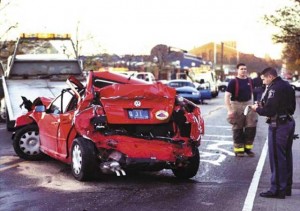
Auto fatalities are, on the whole, heading downward. So why are the numbers rising in a few, unfortunate states, including Colorado and Kansas?
Here’s your old safety nag at it again…yak, yak, yak, safety belts, drinkin’ n’ drivin’, yak, yak, yak. Still, the mainstream media doesn’t pay much attention to automotive safety, except for occasional blasts about purportedly “unsafe” cars, usually reserved for Detroit automakers, and often based on claims by plaintiff lawyers.
But anyone with his or her head screwed on knows better than to blame it all on the car, and I’m here to supply you with facts, occasional opinions and nag-nag-nag.
Among the odds and ends of auto safety news, the National Highway Traffic Safety Administration (NHTSA) has released an eight-page “brief summary” of the almost-final safety stats for 2008-preliminaries were reported in this space months ago-as well as new information on the first quarter of 2009. Readers will recall that nationally, deaths from highway crashes (including “pedalcycles” and pedestrians) last year were down approximately 10% from 2007, as were those involving alcohol-impaired driving. And safety belt usage was up in almost all states.
According to NHTSA, this favorable trend in fewer fatalities continued in the Jan-Feb-Mar period of this year, down approximately nine percent from the comparable period of 2007, and the 12th consecutive quarterly decline. Along with fewer miles being driven by recession-and-gas-price-affected motorists, the U. S. fatality rate per 100 million vehicle miles traveled also declined to an all-time low of 1.12 (in 1967 it was above 5.0).
This ought to be a wake-up call for the states that have fallen behind the national trend, though–as I have pointed out before–percentage changes can be misleading when the absolute numbers are small. In any event, the latest statistics still show that the states with increases in traffic deaths last year were Delaware, New Hampshire, Vermont and Wyoming. Those with increases in alcohol-impaired fatalities were Colorado, Idaho, Kansas, New Hampshire, Oklahoma, Rhode Island and Wyoming.
On the other hand, those states with the biggest percentage reductions (20 % or more) in traffic deaths were Alaska, District of Columbia (treated as a state by NHTSA), Hawaii, Virginia and Wisconsin.
If there is a common thread among these state auto safety performance ratings, good and bad, I didn’t detect it.
Turning now to one of the persistent contributing factors to crashes, substance abuse–even though the nation is experiencing improvement, i.e., fewer fatalities resulting–the Insurance Institute for Highway Safety (IIHS), has reported some interesting facts about ignition interlocks as a barrier against repeat drunk-driving offenders. IIHS is a non-governmental, Washington-based organization funded by insurance companies that all too frequently has seemed to be in the grip of Inside-The-Beltway, self-appointed safety advocates and plaintiff attorneys (the “safety Nazis” as David E. Davis, Jr., branded them). Still, IIHS is a tireless voice and often lonely sentinel watching over vehicle safety, so worth listening to.
IIHS reports that Arkansas, Hawaii, Utah and Wyoming have strengthened ignition interlock laws to include first time DUI offenders; New Mexico has toughened requirements for first-time offenders and Minnesota has expanded a two-county pilot program for interlocks to the whole state. Other states with interlock laws include Alaska, Arizona, Colorado, Illinois, Louisiana, Nebraska, Oregon and Washington. The exact regulations vary from state to state, such as how long a first-timer is required to use the interlock device. I believe judges in other jurisdictions also may have exercised their authority to compel repeat offenders to install the devices.
According to IIHS, “Alcohol ignition interlocks prevent drinking drivers from starting their vehicles. These devices have a breath-testing unit that is connected to the vehicle ignition. To start the vehicle, the driver must blow into the device and register a blood alcohol reading below a predetermined level. If the reading exceeds it, the engine won’t start.”
No doubt there are ways to circumvent these devices. As one safety engineer of my acquaintance once commented in regard to “fool-proof” designs, “Fools are very ingenious people.”
An IIHS study of repeat DUI offenders a decade ago indicated that interlock restrictions reduce the risk of committing an alcohol-related traffic violation within the first year following conviction by 65%. In 2007, according to IIHS (and presumably based on NHTSA data rather than insurance company reports) there were 12,998 fatalities among those drivers with blood-alcohol-content (BAC) at or above .08%, representing 32% of all traffic-related deaths. Interlocks of course won’t do much for drunken pedestrians, where alcohol also has a high responsibility for deadly consequences.
Meanwhile research is continuing on improving the technology of alcohol-detecting devices. It seems a reach today, but whether we like it or not, it is conceivable that sometime in the future, devices could be required in all new vehicles, not just those driven by those with DUI records. There are lots of implications in this, needless to say, and the very possibility is bound to stir controversy.
Too put this in perspective, it’s my understanding that in Sweden, being caught driving drunk automatically withdraws one’s driving privileges. So they are big on having a cold-sober designated driver always available.
Hard to imagine that ever happening in the freedom-loving US of A, but who would have thought a generation ago that we could get safety belt usage up above 80% nationally and as high as 97% in one state, Michigan.
Disclosure: I’m not a blue-nosed Prohibitionist; I enjoy an occasional martini, glass of wine or beer. Long ago I had my college-day sprees. But, now “older and wiser,” I am very mindful of the hazards of driving under the influence, thus discipline myself to limit the enjoyment. To be honest, I don’t like hangovers, either.
So it would be good if we as a nation could eliminate the curse of drunk driving without having built-in breathalyzers in our cars, imposed by Washington for the welfare of the innocent.
